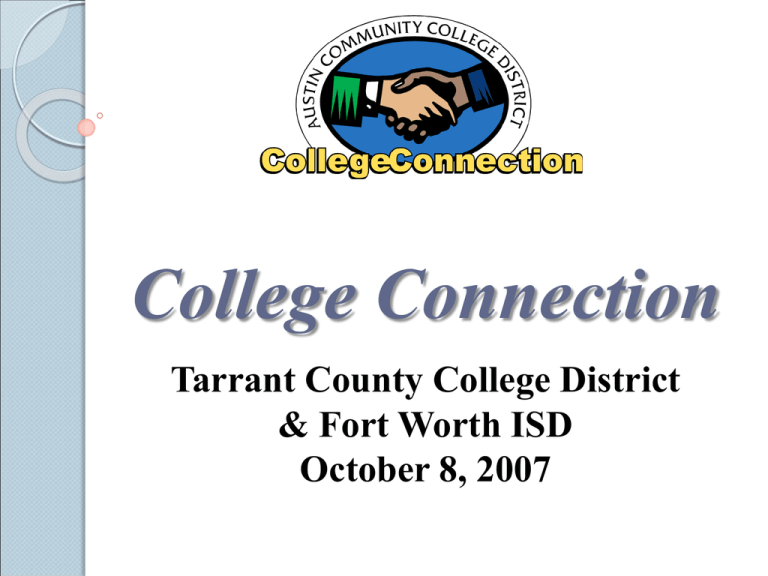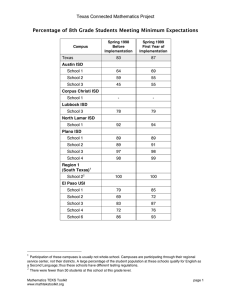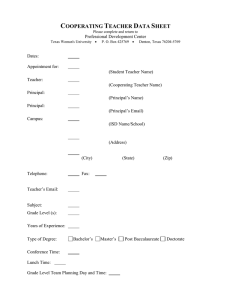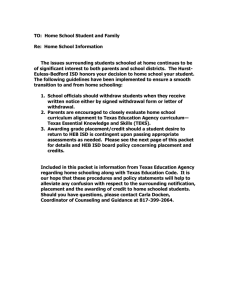College Connection Tarrant County College District & Fort Worth ISD October 8, 2007
advertisement

College Connection Tarrant County College District & Fort Worth ISD October 8, 2007 Presenter Presenter Mary Hensley, Ed.D. Vice President, College Support Systems and ISD Relations mhensley@austincc.edu 512-223-7618 Agenda Closing the Gaps Overview College Connection Overview College Connection How It Works Program Results Program Recognition State and National Interest in Expansion College Connection How To Start Guiding Principles Plan for Success Common Challenges Questions and Answers Texas Higher Education Coordinating Board’s Strategic Plan “Closing the Gaps” Overview Closing the Gaps in Participation Closing the Gaps warns that if more Texans do not receive college degrees by 2030, the State could lose up to $40 billion in annual household income. The goal is to increase student enrollment in higher education by 630,000 by 2015. Most students will elect to start at a community college. Tarrant County College District expects over 22,481 more students by 2015. Source: http://www.thecb.state.tx.us/ClosingtheGaps/ctgtargets_pdf.cfm?Goal=1 College Connection Overview Education Beyond High School Increases earning potential and employment opportunities U.S. Department of Education Improving High School to College Transitions Provide admission and pre-enrollment services to seniors on their school campuses Create an expectation that “College is in everyone’s future.” Increase percentage of high school seniors who enter college after high school graduation. Tarrant County College District Service Area College Transition Rates Texas High School Graduates from FY 2006 Enrolled in Texas Higher Education Fall 2006 School District Arlington ISD Total High School Graduates Students Enrolled in Texas Universities Students Enrolled in Texas 2-year Colleges Students Not Located in Texas Higher Education * 3,527 911 28% 842 26% 1,504 46% 368 73 20% 114 31% 181 49% 1,258 323 26% 363 29% 572 45% Carroll ISD 574 201 35% 84 15% 289 50% Castleberry ISD 127 13 10% 35 28% 79 62% Crowley ISD 782 199 25% 207 27% 376 48% Eagle Mt-Saginaw ISD 478 85 18% 147 31% 246 51% Everman ISD 183 51 28% 38 21% 94 51% 3,515 719 20% 671 19% 2,125 61% Azle ISD Birdville ISD Fort Worth ISD *Includes students who were not enrolled in Texas colleges or universities in the year immediately following graduation, as well as students who were enrolled out-of-state. **Districts with less than 25 graduates are not included in this report. Source: http://www.thecb.state.tx.us/Reports/PDF/1161.PDF Tarrant County College District Service Area College Transition Rates Texas High School Graduates from FY 2006 Enrolled in Texas Higher Education Fall 2006 School District Total High School Graduates Students Enrolled in Texas Universities Students Enrolled in Texas 2-year Colleges Students Not Located in Texas Higher Education * GrapevineColleyville ISD 1,041 409 40% 221 21% 410 39% Hurst-EulessBedford ISD 1,200 273 23% 315 26% 612 51% Keller ISD 1,408 468 33% 417 30% 523 37% Kennedale ISD 186 47 25% 49 26% 90 49% Lake Worth ISD 119 22 19% 31 26% 66 55% 1,373 372 27% 392 29% 609 44% 293 55 19% 81 28% 157 53% 16,162 4,221 26% 4,007 25% 7,933 49% Mansfield ISD White Settlement ISD Total *Includes students who were not enrolled in Texas colleges or universities in the year immediately following graduation, as well as students who were enrolled out-of-state. **Districts with less than 25 graduates are not included in this report. Source: http://www.thecb.state.tx.us/Reports/PDF/1161.PDF Fort Worth ISD Service Area Selected College Transition Rates Texas High School Graduates from FY 2006 Enrolled in Texas Higher Education Fall 2006 Students Enrolled in Texas Universities Students Enrolled in Texas 2-year Colleges Students Not Located in Texas Higher Education * High School Total High School Graduates Carter-Riverside 184 23 13% 35 19% 126 68% Diamond HillJarvis 152 13 8% 24 16% 115 76% Dunbar 179 56 31% 16 9% 107 60% Eastern Hills 254 50 20% 40 16% 164 64% O.D. Wyatt 163 36 22% 31 19% 96 59% Polytechnic 183 13 7% 36 20% 134 73% 75 1 1% 4 5% 70 94% 347 53 15% 77 22% 217 63% 1,537 245 16% 263 17% 1,029 67% Success Trimble Technical Total *Includes students who were not enrolled in Texas colleges or universities in the year immediately following graduation, as well as students who were enrolled out-of-state. **Districts with less than 25 graduates are not included in this report. Source: http://www.thecb.state.tx.us/Reports/PDF/1161.PDF College Connection How It Works College Connection Program Many high school students find the college enrollment process intimidating. Tarrant County College District provides hands-on, one-on-one support to assist every student through each step of the college admissions process. During graduation ceremonies, high school graduating seniors receive acceptance letters to Tarrant County College District. Students Receive Services at the High School: Required • • • • • Admission application ASSET or COMPASS Pre-advising Academic advising Graduation letter Recommended • Senior presentation • Financial aid application Optional • • • • • Student life info Teleconference Campus tours Registration Other College Connection Common Order of On-Campus Activities 1. Senior Presentation 2. Admission application 3. Financial aid application 4. ASSET assessment 5. Tour of Austin Community College campus(es) 6. Pre-Advising 7. Advising 8. Acceptance letter to Austin Community College at graduation 9. Registration for Austin Community College classes Red=Required Blue=Recommended Black=Optional College Connection Activity Grid Sample ISD District Lead: Sandra Dowdy, Assistant Superintendent, 512-386-3040, sdowdy@del-valle.k12.tx.us Del Valle HS Lead: Jean MacInnis, Principal, 512-386-3210, jmacinnis@del-valle.k12.tx.us Admin. Assistant: Nadene Norwood, 512-386-3211, nadene.norwood@del-valle.k12.tx.us ACC District Lead: Mary Hensley, 223-7618, mhensley@austincc.edu Exec. Assistant: Esther Buzard, 223-7618, ebuzard@austincc.edu College Connection Lead: Luanne Preston, 223-7354, luanne@austincc.edu Admin. Assistant: Laurie Clark, 223-7354, lclark2@austincc.edu Senior Count:400 Activity Date Time Location Equipment Communication Del Valle HS Contact (*Lead Contact) name@delvalle.k12.tx.us ACC District Contact (*Lead Contact) name@austincc.edu High School Planning Committee Meeting August 9, 2007 2:00 p.m. – 3:00 p.m. Del Valle Admin 5301 Ross Road Del Valle, TX •E-mail •Announcement *Jean MacInnis Jmacinnis *Luanne Preston luanne College Connection Agreement Prior to beginning Fall semester *Sandra Dowdy Sdowdy *Luanne Preston luanne Senior Presentation Kickoff Activity September 13, 2007 10:30 a.m. – 11:30 a.m. Auditorium •Notice in parent newsletter •Notice on high school website *Sarah Mabry Sarah.mabry *Ashley Williams awillia4 Admissions Application October 10, 2007 8:30 a.m. – 4:00 p.m. Rooms A205, C216, D130, D208 •Non-citizen students must obtain alternate ID before completing application *Sarah Mabry Sarah.mabry *Pat Colunga pcolunga Make-Up Day SHADE/BOLD – Required College Connection Activities Lifetime Acceptance “at ACC” Application never discarded Provide a permanent college home Students come to ACC: ◦ ◦ ◦ ◦ ◦ ◦ Full-time Part-time In Summer for transfer After military service After career changes Co-enroll while attending 4-year institution Lifetime Acceptance “at ACC” Cohorts can be tracked by semester of entry Longitudinal data collected for ◦ Retention ◦ Completion ◦ Success Program Results College Connection Program Growth Over 4 years: 1 school district to 27 school districts 2 high schools to 58 high schools 400 students to 17,000+ students The College Connection Program Works! ISD San Marcos Austin Bastrop Del Valle Leander Hays Manor Pflugerville Students NOT located in Texas Higher Education Fall 2003 Students NOT located in Texas Higher Education Fall 2004 Students NOT located in Texas Higher Education Fall 2005 Students NOT located in Texas Higher Education Fall 2006 Number Number Number Number 273 2,155 286 293 444 281 51 194 Percent 66% 56% 69% 77% 48% 57% 57% 47% 219 2,066 234 312 459 309 74 201 Percent 55% 56% 57% 80% 48% 56% 57% 47% 234 2,005 239 236 422 290 87 204 Percent 59% 54% 54% 66% 42% 55% 62% 48% 294 2,014 282 229 418 286 89 156 2006 Increase of Students in Higher Ed Since Implementation Percent 66% 52% 61% 71% 40% 51% 68% 46% 0% 4% -4 % 9% 8% 5% -6 % 2% Blue=Year College Connection started Red=Year Seniors attend ACC after College Connection 1-Source: http://www.txhighereddata.org/Reports/PDF/0961.pdf 2-Source: http://www.txhighereddata.org/Reports/PDF/0963.pdf 3-Source: http://www.thecb.state.tx.us/Reports/PDF/1161.PDF College Connection Diversity of Participants 2006-07 Traditionally Underrepresented in Higher Education - Students Enroll at ACC More than 55% of College Connection enrollees are minorities Higher percentage entering ACC through College Connection than in the general ACC student population College Connection Positively Impacts Other College Programs ACC Fall Enrollments ◦ ◦ Early College Start (Dual Credit) Enrollments ◦ ◦ ◦ 38% increase first year 59% increase over two years 26% increase in enrollment from ‘04 to ’05 45% increase in enrollment from ’04 to ’06 3,209 students enrolled Summer 2007 (recordbreaking ECS enrollment) Tech Prep Enrollments ◦ 4,336% increase in enrollment from ‘03 to ‘06 36 students in 2003-04 48 students in 2004-05 293 students in 2005-06 1,597 students in 2006-07 Program Recognition College Connection Program National Acclaim & Recognition Awards Received • THECB Star Award • Excelencia in Education Award Award Recipient November 2006 Semi-Finalist October 2006 • Bellwether Award Award Recipient January 2007 State and National Interest in Expansion National Interest: Florida Department of Education Launched state-wide campaign in April 2007 called “Go Higher-Get Accepted” modeled after College Connection Maine Interest in College Connection Proposed law requiring graduating high school seniors to complete at least one college application before getting diploma. Support from “Compact for Higher Education” “Attaining advanced levels of education for disadvantaged students cannot be done without developing a college-going culture in every middle school and high school in the state of Texas...then suddenly, (going to college) changes from being a possibility to an expectation.” --Raymund Paredes Commissioner, Texas Higher Education Coordinating Board January 6, 2005 THECB Statewide College Connection Expansion 2007-2009 • Ten Colleges Receive Implementation Grants • Alamo Community College District • Blinn College • Del Mar College • Houston Community College System • Lee College • Odessa College • Richland College • South Texas College • Tarrant County College District • Weatherford College THECB Statewide College Connection Expansion 2007-2009 • Five Colleges Receive Planning Grants • Cedar Valley College • Cisco Junior College • Northeast Texas Community College • Paris Junior College • Victoria College THECB Statewide College Connection Expansion • Colleges Already Adopting College Connection • Alamo Community College District • Central Texas College • Coastal Bend Community College • Del Mar Community College • Houston Community College District • Temple Community College • Vernon College • Victoria Community College College Connection: How To Start Formal Agreement Between college and school district Signed by chancellor and/or president and superintendent Establishes transfer of student data from high school to college Details responsibilities and expectations Advance Briefing District/Central High Office Staff School Principal Planning Meeting One meeting held annually in Summer or Fall Schedule one hour (slightly longer for new schools or multiple schools) Complete activity grid Focus on scheduling Leave activity details for * contacts Communications between School District and College Electronic via list serv Updated activity grid sent via e-mail when changes occur College Connection website links iCal ◦ Combined calendar for internal use Data Collection Very Important Collect electronically (Excel spreadsheet) Collect from high school ◦ ◦ ◦ ◦ ◦ Name Address DOB HS Student ID (for later record matching) Test Scores (HS Exit Exam, SAT, ACT) Mark records as College Connection cohort in student database Data Follow-Up Track by school, how many students complete each activity May need multiple visits to get 100% participation Give high school principal participation rates for use at graduation announcement ceremony Report Fall enrollment from pilot schools (compare to benchmark), Spring persistence Austin Community College College Connection Website www.austincc.edu/isd Access to scheduled activities for students, parents, and school officials Calendars Links to pertinent ACC school district sites Website Participating Links schools to school pages Link to college pages of interest Press coverage/special events College Connection Logo College Connection: Guiding Principles Guiding Principles: Sequencing Activities When to schedule activities? ◦ Senior Presentation Prior to first activity, as soon as possible after school starts Usually admissions follows ◦ Admissions Application Fall Semester After receipt of data roster In time, where possible, for seniors to prepare for Spring dualcredit registration Guiding Principles: Sequencing Activities When to schedule activities? ◦ Assessment End of January through early March After receipt of test score roster – timed to allow maximum number of SAT/ACT test scores to be included Allows students to receive the most instructional content prior to testing ◦ Financial Aid Mid-January through Mid-March Presentations timed to coincide with W-2 arrival, tax preparation, and meet college priority filing deadlines Night presentations and workshops for parents and students Financial Aid Saturdays Guiding Principles: Sequencing Activities When to schedule activities? ◦ New Student Orientation ACC calls this step “pre-advising” Completed online as ACC 101 Live program replaced by online module per school request School manages where and when students complete Student prints checklist as proof of completion Many schools schedule during advisory Schedule window of time prior to academic advising Recommend 1-3 weeks prior to advising session Guiding Principles: Sequencing Activities When to schedule activities? ◦ Academic Advising Mid-February through Mid-April Allow time, if needed, for test scores to be entered or processed and available to advisors ACC requires three weeks is using ASSET ◦ Complete all College Connection activities by MidApril Guiding Principles: Scheduling The planning meeting for each school should occur before Fall semester, or as soon after school starts as possible All events should be completed by Mid-April with rare exceptions ◦ The month of May through end of school is extremely busy on high school campuses A student should be able to complete an individual activity (exception assessment testing) with one bell period Guiding Principles: Scheduling– How Much Time? Senior Presentation – 20 minutes Admissions Application – 25 minutes ◦ Residency Form ◦ Missing Credentials Assessment – 5 hours ◦ Partial testing takes less time Math only – 1 hour Reading/writing – 2.25 hours Pre-Advising – 25 minutes Advising – 15 minutes average Planning Meeting Recommended Participants College High School District lead person Principal Implementation lead person Grade level principal or AP Team leader for services Lead or senior counselor Person in charge of testing/scheduling Tech person (use of computer labs) Other staff who works with the “senior class” ◦ ◦ ◦ ◦ ◦ ◦ Admissions representative Financial Aid representative Assessment representative Recruitment representative Advising representative Recorder Planning Meeting Recommended Things to Bring College High School College Calendar Bell schedule Admissions Team Calendar School calendar Financial Aid Team Calendar A/B Block scheduling Assessment Team Calendar Testing calendar Student Recruitment Team Calendar Advising Team Calendar High School—College Partnership Plan for Success Central Office Staff Sign formal agreement before beginning ◦ Work with superintendent Understand and vocally support College Connection program ◦ Announce program in meetings, newsletters, e-mails Ensure your Board is informed ◦ Invite TCCD to do a brief presentation Central Office Staff Participate/help schools participate in “launch” activities ◦ Press conference ◦ Campus tours, celebrations, or special events Attend as many campus planning meetings as possible ◦ Planning meetings to be held before activities begin on campuses ◦ Lays the foundation for organized program activities ◦ Everyone is literally “on the same page” Central Office Staff Expect 100% participation – make expectations clear to school staff Provide support for school staff in scheduling all activities during school days ◦ There is no other way to have 100% participation Support and justify the pilot program for schools not yet participating Principal Understand and vocally support College Connection program ◦ Announce program in meetings, newsletters, e-mails Participate in your campus planning meeting Clear obstacles – allow access Assign a positive, helpful, supportive “asterisk” person to coordinate each activity Principal Allow the use of necessary school facilities during the school day for activities (computer labs, gyms for testing, etc.) Help faculty understand your support for the program ◦ Students will be pulled out of classes 3 or 4 times during the year Understand College Connection as a process with sequenced activities ◦ Time is needed between activities Emphasize the importance of 100% participation ◦ Allow repeated access, if necessary, to ensure that all students are included Principal Assign staff to accompany students to College Connection activities ◦ To help keep order ◦ To personally identify students to TCCD staff Ensure that your school website features College Connection Help solve any problems that may arise ◦ During an activity ◦ During the school year ◦ Call College Connection contacts if needed Principal Recognize College Connection at graduation ceremonies; some examples ◦ Announce how many students receive acceptance letter ◦ Ask College Connection students to stand Ensure students receive TCCD acceptance letter along with their diploma Ensure final, official high school transcripts for all students given to TCCD at the end of the school year Counselor Understand and vocally support the program ◦ Announce in Meetings with classes Senior assemblies To individual students “Counselor’s corner” of the school newsletter E-mails to parents Participate in your campus planning meeting Clear obstacles – allow access Be one of the positive, helpful, supportive “asterisk” people coordinating one or more College Connection activities Counselor Help find alternatives that allow the use of facilities for College Connection activities (computer labs, gyms for testing, etc.) Help colleagues understand your support and that students will be pulled out of classes 3-4 times during the year Understand that College Connection is a process and that sequenced activities (with some time between the activities) are important Counselor Understand the importance of 100% participation ◦ Help students understand the benefits of College Connection even if the student has applied or been accepted to another college Free testing FAFSA Easy entrance Higher income for more education Accompany students to College Connection activities ◦ Help keep order ◦ Personally identify students to TCCD staff Ensure that College Connection is featured on your school website Counselor Help solve any problems that may arise during an activity, or during the school year ◦ Call College Connection officials, if needed Ensure that students receive the TCCD acceptance letter along with their diploma Ensure that official high school transcripts for all students are given in a batch to TCCD at the end of the school year ◦ Saves time for students when enrolling ◦ Makes process smoother for students not entering directly after graduation Common Challenges Challenge #1 – Faculty Resistance Why does this occur? ◦ Faculty not well-informed about the program ◦ Some have traditional bias against community colleges Concerns about quality of programs/instruction and transferability of classes Strategy – Counter Faculty Resistance Feature a College Connection presentation at general faculty meeting Provide general information about TCCD programs, costs, state-wide transfer of classes between public institutions Provide dates of pullouts well in advance, to allow for faculty planning Emphasize benefits to students ◦ Students will be “ready-to-register” at TCCD at the end of the year Challenge #2 – Student Resistance Why does this occur? ◦ Students not exposed to the program in advance ◦ Some are convinced they are going to college elsewhere or convinced they won’t need to go at all ◦ A “cool” student has refused to participate Strategy – Lessen Student Resistance Schedule a College Connection senior presentation before activities begin Encourage participation and explain program benefits to any student refusing to participate Recruit school opinion leaders and role models to influence their peers Challenge #3 – Alleviate Parent Concerns Why does this occur? ◦ Parents don’t want to give sensitive family income information to students, school or college staff ◦ No computer access at home ◦ Parents’ work schedule prevents easy completion Strategy – Counter Parent Resistance on FAFSA Time school FAFSA activities to coincide with arrival of W-2 and filing of taxes Provide evening FAFSA workshops – invite TCCD to participate or lead Coordinate with volunteer programs that assist families with preparing/filing taxes Provide information about necessary documents/information in advance to parents Questions and Answers For copies: PowerPoint Presentation: www.austincc.edu/isd/tarrant/100807Presentation.ppt


